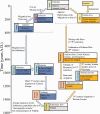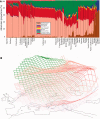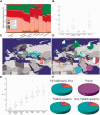Localizing Ashkenazic Jews to Primeval Villages in the Ancient Iranian Lands of Ashkenaz
- PMID: 26941229
- PMCID: PMC4860683
- DOI: 10.1093/gbe/evw046
Localizing Ashkenazic Jews to Primeval Villages in the Ancient Iranian Lands of Ashkenaz
Abstract
The Yiddish language is over 1,000 years old and incorporates German, Slavic, and Hebrew elements. The prevalent view claims Yiddish has a German origin, whereas the opposing view posits a Slavic origin with strong Iranian and weak Turkic substrata. One of the major difficulties in deciding between these hypotheses is the unknown geographical origin of Yiddish speaking Ashkenazic Jews (AJs). An analysis of 393 Ashkenazic, Iranian, and mountain Jews and over 600 non-Jewish genomes demonstrated that Greeks, Romans, Iranians, and Turks exhibit the highest genetic similarity with AJs. The Geographic Population Structure analysis localized most AJs along major primeval trade routes in northeastern Turkey adjacent to primeval villages with names that may be derived from "Ashkenaz." Iranian and mountain Jews were localized along trade routes on the Turkey's eastern border. Loss of maternal haplogroups was evident in non-Yiddish speaking AJs. Our results suggest that AJs originated from a Slavo-Iranian confederation, which the Jews call "Ashkenazic" (i.e., "Scythian"), though these Jews probably spoke Persian and/or Ossete. This is compatible with linguistic evidence suggesting that Yiddish is a Slavic language created by Irano-Turko-Slavic Jewish merchants along the Silk Roads as a cryptic trade language, spoken only by its originators to gain an advantage in trade. Later, in the 9th century, Yiddish underwent relexification by adopting a new vocabulary that consists of a minority of German and Hebrew and a majority of newly coined Germanoid and Hebroid elements that replaced most of the original Eastern Slavic and Sorbian vocabularies, while keeping the original grammars intact.
Keywords: Ashkenaz; Ashkenazic Jews; Rhineland Hypothesis; Yiddish; archaeogenetics; geographic population structure (GPS).
© The Author 2016. Published by Oxford University Press on behalf of the Society for Molecular Biology and Evolution.
Figures






Similar articles
-
The Origins of Ashkenaz, Ashkenazic Jews, and Yiddish.Front Genet. 2017 Jun 21;8:87. doi: 10.3389/fgene.2017.00087. eCollection 2017. Front Genet. 2017. PMID: 28680441 Free PMC article.
-
Yiddish Language and Ashkenazic Jews: A Perspective from Culture, Language, and Literature.Genome Biol Evol. 2016 Jul 2;8(6):1948-9. doi: 10.1093/gbe/evw131. Genome Biol Evol. 2016. PMID: 27289098 Free PMC article. Review.
-
Pitfalls of the Geographic Population Structure (GPS) Approach Applied to Human Genetic History: A Case Study of Ashkenazi Jews.Genome Biol Evol. 2016 Aug 16;8(7):2259-65. doi: 10.1093/gbe/evw162. Genome Biol Evol. 2016. PMID: 27389685 Free PMC article. Review.
-
No evidence from genome-wide data of a Khazar origin for the Ashkenazi Jews.Hum Biol. 2013 Dec;85(6):859-900. doi: 10.3378/027.085.0604. Hum Biol. 2013. PMID: 25079123
-
Origin and spread of the 1278insTATC mutation causing Tay-Sachs disease in Ashkenazi Jews: genetic drift as a robust and parsimonious hypothesis.Hum Genet. 2004 Mar;114(4):366-76. doi: 10.1007/s00439-003-1072-8. Epub 2004 Jan 15. Hum Genet. 2004. PMID: 14727180
Cited by
-
IHH enhancer variant within neighboring NHEJ1 intron causes microphthalmia anophthalmia and coloboma.NPJ Genom Med. 2023 Aug 14;8(1):22. doi: 10.1038/s41525-023-00364-x. NPJ Genom Med. 2023. PMID: 37580330 Free PMC article.
-
Believing and social interactions: effects on bodily expressions and personal narratives.Front Behav Neurosci. 2022 Oct 6;16:894219. doi: 10.3389/fnbeh.2022.894219. eCollection 2022. Front Behav Neurosci. 2022. PMID: 36275855 Free PMC article.
-
Principal Component Analyses (PCA)-based findings in population genetic studies are highly biased and must be reevaluated.Sci Rep. 2022 Aug 29;12(1):14683. doi: 10.1038/s41598-022-14395-4. Sci Rep. 2022. PMID: 36038559 Free PMC article.
-
Population genetic considerations for using biobanks as international resources in the pandemic era and beyond.BMC Genomics. 2021 May 17;22(1):351. doi: 10.1186/s12864-021-07618-x. BMC Genomics. 2021. PMID: 34001009 Free PMC article. Review.
-
Possible ethnic associations in primary hyperoxaluria type-III-associated HOGA1 sequence variants.Mol Biol Rep. 2021 Apr;48(4):3841-3844. doi: 10.1007/s11033-021-06380-3. Epub 2021 May 4. Mol Biol Rep. 2021. PMID: 33948853 Review.
References
-
- Baron SW. 1937. Social and religious history of the Jews. Vol. 1. New York: : Columbia University Press.
-
- Baron SW. 1952. Social and religious history of the Jews. Vol. 2. New York: : Columbia University Press.
-
- Baron SW. 1957. Social and religious history of the Jews. vol 3. High middle ages: heirs of Rome and Persia. New York: : Columbia University Press.
Publication types
MeSH terms
Grants and funding
LinkOut - more resources
Full Text Sources
Other Literature Sources
Miscellaneous

